现代英语词汇学概论chapter6
- 格式:ppt
- 大小:400.00 KB
- 文档页数:20
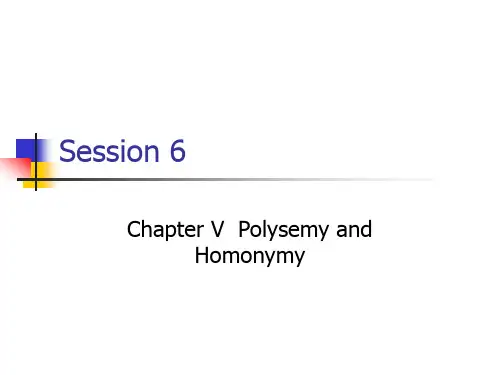
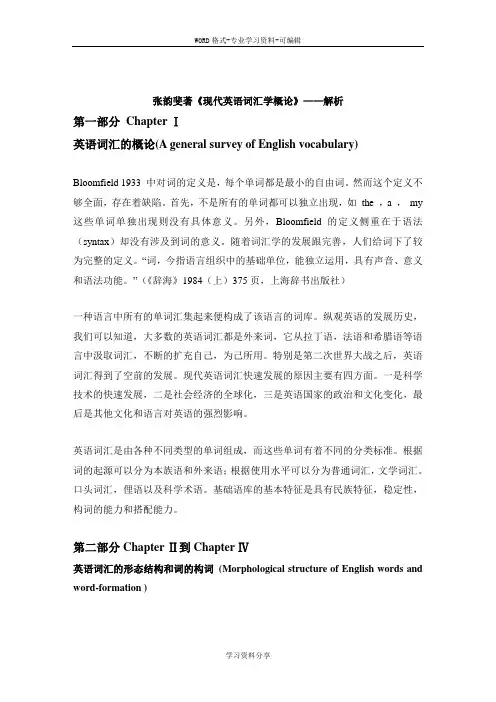
张韵斐著《现代英语词汇学概论》——解析第一部分Chapter Ⅰ英语词汇的概论(A general survey of English vocabulary)Bloomfield 1933 中对词的定义是,每个单词都是最小的自由词。
然而这个定义不够全面,存在着缺陷。
首先,不是所有的单词都可以独立出现,如the ,a ,my 这些单词单独出现则没有具体意义。
另外,Bloomfield的定义侧重在于语法(syntax)却没有涉及到词的意义。
随着词汇学的发展跟完善,人们给词下了较为完整的定义。
“词,今指语言组织中的基础单位,能独立运用,具有声音、意义和语法功能。
”(《辞海》1984(上)375页,上海辞书出版社)一种语言中所有的单词汇集起来便构成了该语言的词库。
纵观英语的发展历史,我们可以知道,大多数的英语词汇都是外来词,它从拉丁语,法语和希腊语等语言中汲取词汇,不断的扩充自己,为己所用。
特别是第二次世界大战之后,英语词汇得到了空前的发展。
现代英语词汇快速发展的原因主要有四方面。
一是科学技术的快速发展,二是社会经济的全球化,三是英语国家的政治和文化变化,最后是其他文化和语言对英语的强烈影响。
英语词汇是由各种不同类型的单词组成,而这些单词有着不同的分类标准。
根据词的起源可以分为本族语和外来语;根据使用水平可以分为普通词汇,文学词汇。
口头词汇,俚语以及科学术语。
基础语库的基本特征是具有民族特征,稳定性,构词的能力和搭配能力。
第二部分Chapter Ⅱ到Chapter Ⅳ英语词汇的形态结构和词的构词(Morphological structure of English words and word-formation )(一)词素(Morphemes)单词是有词素(morphemes)构成的。
词素即英语语言中有意义的最小单位,同时具有声音和意义。
单词可以有一个或一个以上的词素组成。
如:nation 是一个词素,national有nation+al 两个词素。

张韵斐著《现代英语词汇学概论》——解析第一部分Chapter Ⅰ英语词汇的概论(A general survey of English vocabulary)Bloomfield 1933 中对词的定义是,每个单词都是最小的自由词。
然而这个定义不够全面,存在着缺陷。
首先,不是所有的单词都可以独立出现,如the ,a ,my 这些单词单独出现则没有具体意义。
另外,Bloomfield的定义侧重在于语法(syntax)却没有涉及到词的意义。
随着词汇学的发展跟完善,人们给词下了较为完整的定义。
“词,今指语言组织中的基础单位,能独立运用,具有声音、意义和语法功能。
”(《辞海》1984(上)375页,上海辞书出版社)一种语言中所有的单词汇集起来便构成了该语言的词库。
纵观英语的发展历史,我们可以知道,大多数的英语词汇都是外来词,它从拉丁语,法语和希腊语等语言中汲取词汇,不断的扩充自己,为己所用。
特别是第二次世界大战之后,英语词汇得到了空前的发展。
现代英语词汇快速发展的原因主要有四方面。
一是科学技术的快速发展,二是社会经济的全球化,三是英语国家的政治和文化变化,最后是其他文化和语言对英语的强烈影响。
英语词汇是由各种不同类型的单词组成,而这些单词有着不同的分类标准。
根据词的起源可以分为本族语和外来语;根据使用水平可以分为普通词汇,文学词汇。
口头词汇,俚语以及科学术语。
基础语库的基本特征是具有民族特征,稳定性,构词的能力和搭配能力。
第二部分Chapter Ⅱ到Chapter Ⅳ英语词汇的形态结构和词的构词(Morphological structure of English words and word-formation )(一)词素(Morphemes)单词是有词素(morphemes)构成的。
词素即英语语言中有意义的最小单位,同时具有声音和意义。
单词可以有一个或一个以上的词素组成。
如:nation 是一个词素,national有nation+al 两个词素。
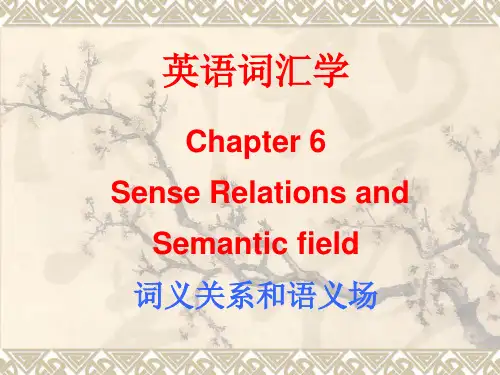

Word:a minimum free form of a language. With a unity of sound and meaning (both lexical meaning and grammatical meaning),performing syntactic meaningCriteria of words: by origin (native—old English)( and loan language—borrowed English), by level of usage(common words,literary ,colloquial,slang and technical words);by notions(function and content words)Morpheme:smallest meaningful linguistic unit of language, not divisible or analyzable into smaller form. A morpheme is also two—facet language unit which possesses sound and meaning。
Classification of morphemes:Free morpheme:utter alone with meaning(a free morpheme is a word in traditional sense)man, read, writeBound morpheme: must appear with one other morpheme,u nkind, happily , receiveRoot:the basic unchangeable part of the word;convey the main lexical meaning of the word; Either free or bound(1)free roots:many roots are free morphemes, such asboy ,moon,walk(2)bound roots: derived from foreign sources。
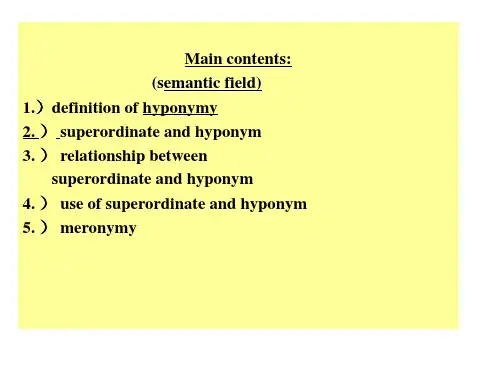
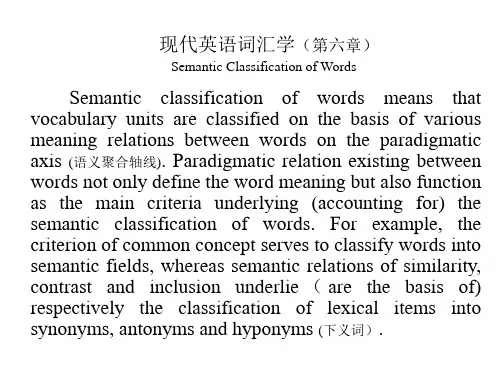
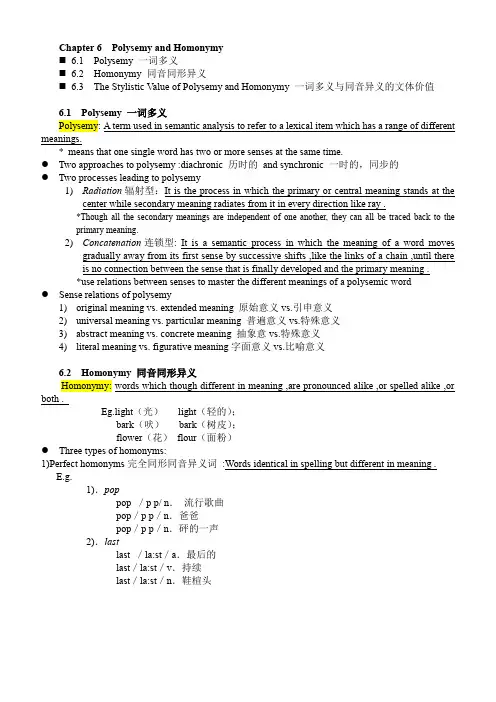
Chapter 6 Polysemy and Homonymy⏹6.1 Polysemy 一词多义⏹6.2 Homonymy 同音同形异义⏹6.3 The Stylistic Value of Polysemy and Homonymy 一词多义与同音异义的文体价值6.1 Polysemy 一词多义Polysemy: A term used in semantic analysis to refer to a lexical item which has a range of different meanings.*means that one single word has two or more senses at the same time.●Two approaches to polysemy :diachronic 历时的and synchronic 一时的,同步的●Two processes leading to polysemy1)Radiation辐射型:It is the process in which the primary or central meaning stands at thecenter while secondary meaning radiates from it in every direction like ray .*Though all the secondary meanings are independent of one another, they can all be traced back to the primary meaning.2)Concatenation连锁型: It is a semantic process in which the meaning of a word movesgradually away from its first sense by successive shifts ,like the links of a chain ,until thereis no connection between the sense that is finally developed and the primary meaning .*use relations between senses to master the different meanings of a polysemic word●Sense relations of polysemy1)original meaning vs. extended meaning 原始意义vs.引申意义2)universal meaning vs. particular meaning 普遍意义vs.特殊意义3)abstract meaning vs. concrete meaning 抽象意vs.特殊意义4)literal meaning vs. figurative meaning字面意义vs.比喻意义6.2 Homonymy 同音同形异义Homonymy: words which though different in meaning ,are pronounced alike ,or spelled alike ,or both .Eg.light(光)light(轻的);bark(吠)bark(树皮);flower(花)flour(面粉)●Three types of homonyms:1)Perfect homonyms完全同形同音异义词:Words identical in spelling but different in meaning .E.g.1).poppop /p p/ n.流行歌曲pop/p p/n.爸爸pop/p p/n.砰的一声2).lastlast /la:st/a.最后的last/la:st/v.持续last/la:st/n.鞋楦头现代英语词汇学概论最强版复习资料chapter62)Homophones同音异义词:Words identical in sound but different in spelling and meaning.Eg. air空气–heir继承人,后嗣bear忍受,熊–bare空的,赤裸的dear 亲爱的–deer鹿3)Homograph同形异音异义词:Words identical in spelling but different in sound and meaning .Eg. lead sow tear prayerSources of homonyms1.Phonetic convergenceUnder the influence of phonetic convergence ,two or more words whichonce were different in sound forms take on the same pronunciation thespoken language .E.g. melo –meal bean –been beat –beet flea –flee heal –heel2.Semantic divergenceWhen two or more meanings of the same word drift apart to such an extentthat there will be no obvious connection between them ,polysemy will giveplace to homonymy .E.g. flour –flower metal –mettle3.Foreign influenceE.g. host –one who entertains guest [L hospitis ]host –a large number ,an army [L hostis ,army ,hostile force ]4.ShorteningThis source is of decidedly subsidiary importance in formal writing but haswidespread influence in everyday speech.E.g. pop –popular (music )-to thrust ,to push (up ) 推6.3 The Stylistic Value of Polysemy and Homonymy一词多义与同音异义的文体价值Context plays a very important role in the hearer 's interpretation of words of two special types: different words of like form(homonymy)and words of several meanings (polysemy ).*Polysemic and homonymous words are stylistically useful to achievehumour or irony ,or to heighten dramatic effect .。

张韵斐著《现代英语词汇学概论》——解析第一部分Chapter Ⅰ英语词汇的概论(A general survey of English vocabulary)Bloomfield 1933 中对词的定义是,每个单词都是最小的自由词。
然而这个定义不够全面,存在着缺陷。
首先,不是所有的单词都可以独立出现,如the ,a ,my 这些单词单独出现则没有具体意义。
另外,Bloomfield的定义侧重在于语法(syntax)却没有涉及到词的意义。
随着词汇学的发展跟完善,人们给词下了较为完整的定义。
“词,今指语言组织中的基础单位,能独立运用,具有声音、意义和语法功能。
”(《辞海》1984(上)375页,上海辞书出版社)一种语言中所有的单词汇集起来便构成了该语言的词库。
纵观英语的发展历史,我们可以知道,大多数的英语词汇都是外来词,它从拉丁语,法语和希腊语等语言中汲取词汇,不断的扩充自己,为己所用。
特别是第二次世界大战之后,英语词汇得到了空前的发展。
现代英语词汇快速发展的原因主要有四方面。
一是科学技术的快速发展,二是社会经济的全球化,三是英语国家的政治和文化变化,最后是其他文化和语言对英语的强烈影响。
英语词汇是由各种不同类型的单词组成,而这些单词有着不同的分类标准。
根据词的起源可以分为本族语和外来语;根据使用水平可以分为普通词汇,文学词汇。
口头词汇,俚语以及科学术语。
基础语库的基本特征是具有民族特征,稳定性,构词的能力和搭配能力。
第二部分Chapter Ⅱ到Chapter Ⅳ英语词汇的形态结构和词的构词(Morphological structure of English words and word-formation )(一)词素(Morphemes)单词是有词素(morphemes)构成的。
词素即英语语言中有意义的最小单位,同时具有声音和意义。
单词可以有一个或一个以上的词素组成。
如:nation 是一个词素,national有nation+al 两个词素。
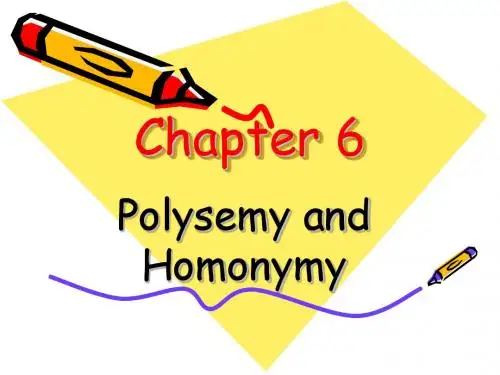

第六章词汇:Polysemy n. 一词多义peculiar n. 特权;特有财产adj. 特殊的Diachronic 历时性Synchronic 共时性Radiation 放射法garments n. [服装] 服装,衣着Concatenation n. 串联,连结tern 三个一组的candidate n. 候选人preceding v. 在...之前Homonyms n. [语] 同形同音异义词identical adj. 同一的;完全相同的Homographs同形异义词Homophones 同音异形异义Rhetoric 修辞puns n. 双关语sarcasm n. 讽刺ridicule n. 嘲笑embrace vt. 拥抱;信奉,皈依;包含connotation n. 内涵Antonymy 反义词predecessor 前任vice versa 反之亦然Hyponymy 上下位关系要点一. 1.Polysemy—polysemy is a common feature peculiar to all natural languages. When a words is first coined, it always monosemic, butin the course of development , the same word may have two or more different meanings.e.g. The word "flight" may mean "passing through the air", "power of flying", "air of journey", etc.2.Two approaches1).( Diachronic approach –Diachronically, polysemy is assumed to be the result of growth and development ofthe semantic structure of one and same word.This first meaning is the primary meaning. With the advance of timeand the development of language, it took on more and more meanings. These latter meanings are called derived meanings.E.g. faceThe primary meaning gave birth to new meaning.The primary meaning become either absolute or disappeared altogetherE.g. harvesttime of cutting reaping and gathering the cropsa season‘s yield of grain or fruitPain penalty or punishment pains and penaltyupon/under pain of suffering2).Synchronic approach –synchronically, polysemy is viewed as the coexistent of various meaning of the same word in a certain historical period of time.The basic meaning of a word is the core of word meaning.The core of word meaning called the central meaning (secondary meaning).The central meaning has gradually dimished in currency with the changes and one ofthe derived meanings has become dominant.E.g. gay3.Two process of development1). Radiation-a semantic process which shows that the primary meaning stands at the center and each of the derived meanings proceed out of in every direction like rays.The meanings are independent of one another, but can all be tracked back to thecentral meaning.e.g. Neck1) That part of a man or animal jointing the head to the body2) That part of the garments3) The neck of an animal used as food4) A narrow part between the head and body or base of any object5) The part of anythingOf the 5 meanings 1) is the primary and all the rest are derived but each of the otherfour is directly related to 1).Therefore, we say neck has developed through the process of radiation.2).Concatenation –meaning ―linking together, is the semantic process in which the meaning of a word moves gradually away from its first sense by successive shifts until,in many cases, there is not a sign of connectionbetween the sense that is finally developed and that which the term hadat the begining.e.g. candidate1) White-robed adj. 穿白色长袍的2) Office seeker in white gouns3) A person who seeks an office4) A person proposed for a place, award, etc.Of the 4 meanings, 1) is the primary meaning and the other three are derived, but each of the derived meaning isonly directly related to the preceding one and there is no direct connection between 1) and 4). Therefore, we saycandidate has developed through the process of concatenation.3).DifferenceRadiation and concatenation is closely related, being different stages of thedevelopment leading to polysemy.Radiation, each of the derived meaning is directly connected to the primary meaning.Concatenation, each of the later meaning is related only to the preceding one likechains. Though the latest sensecan be tracked to the original, there‘s no direct connection in between.The two processes work together, complementing each other.Radiation precedes concatenation.1.Homonyms--are generally defined as words different in meaning but either identical both i n s ound and spellingor identical only in sound or spelling.2.1).Perfect Homonyms--are words identical both in sound and spelling, but different in meaning.e.g. bank/bank ,bear/bear ,date/date2).Homographs--are words identical only in spelling but different in sound and meaning.e.g. Bow/bow ,Sow/sow3).Homophones (most common)--are words identical only in sound but different in spelling a nd meaning.e.g. Dear/dear ,Right/rite ,Son/sun3.Origins of Homonyms1). Change in sound and spelling(homonyms are native by origin, derived from different earlier forms in OldEnglish. The change in sound and spelling gradually made them identical in modernEnglish.)e.g. ear/ear ,long/long2). Borrowing (many words of foreign origin coincide in sound and/or spelling withthose of native origin with those of other foreign origin.)e.g. fair/fair,ball/ball3). Shortening (many shortened forms of words happen to be identical with otherwords in spelling or sound)e.g. ad/add,rock/rock ,NOW/now4.Differentiation of Homonyms and polysemants(Perfect homonyms and polysemants are fully identical regard to spelling and pronunciation. )Homonyms refer to different word, which happen to share the same forms.Polysemant is the one and some word, which has several meanings.1).One important criterion is to see their etymology. Homonyms are from differen tsources. A polysemant is from the same source,which has acquired different meaning in the course of development.2). The second principle is semantic relatedness.The various meanings of a polysemant are correlated andconnected to some central meaning to a greater or less degree. Meanings of different homon yms have nothing to do with one another.5.Rhetoric featureThey create puns for desired effect of, say, humour, sarcasm or ridicule.三.1.Synonyms—are words different in sound and spelling but most nearly alike or exactly the same in mean ing.Synonyms share a likeness in denotation and in part of speech.2.Types of Synonyms1).Absolute (Complete) Synonyms--are words, which are identical in meaning inall its aspects, both in grammatical meaning and lexical meaning,including c onceptual and associative meanings.Absolute (Complete) Synonyms are restricted to high-specialized vocabulary.For instance, composition / compounding. They have the perfect same meaningin Lexicology.2).Relative (Near) synonyms--are similar or nearly the same in denotation but embrace different shades of meaning or different degrees of a given quality.e.g. Change/alter/varyTake stagger/reel/totter for example.Stagger implies unsteady movement characterized by a loss of balance and failure to maintai n a fixed course.E.g. stagger under a heavy load;Reel suggests a swaying or lurching so as to appear on the verge of falling.E.g. The drunken man reeled down the hall;Totter indicates the uncertain, faltering steps of a feeble old person or of an infant learning to walk.3.Sources of Synonyms1).Borrowing: (the most important source)2).Dialects and regional English:eg.Railway (BrE) railroad (AmE)Mother (BrE) minny (ScotE)Charm (BrE) glamour (ScotE)Ranch (AmE) run (AusE)Job (StandE) gig (BlackE)Jim (BlachE) mal person (StandE)3).Figurative a. 比喻的,象征的and euphemistic a.委婉的use of words:Occupation walk of life (fig.)Dreamer star-gazer (fig.)Drunk elevated (euph.)Lie distort the fact (euph.)4).Coincidence with idiomatic expressions:Win gain the upper handDecide make up one‘s mindFinish get throughHesitate be in two mindsHelp lend one a hand4.Discrimination of Synonyms1) Difference in denotation: differ in the range and intensity of meaning.Range (some words have a wider range of meaning than others)e.g. timid--timorousTimid is applied to the state of minds in which a person may happen to be at the moment, ant to the habitual disposition.Timorous is only to the disposition.Comprehend/ understandextend—increase—expandThe owner of the restaurant is going to extend the kitchen by ten feet this year. The company has decided to increase its sales by ten percent next year.The metal will expand if heated.Extent increase expand Differ in degree of intensitye.g. wealth—richThe wealth person is to posses more money and property than a rich man.work – toilWork is a general term having no special implications as ‗light‘ or ‗heavy‘, and‗mental‘ or ‗physical‘.Toil suggests ‗heavy and tiring work‘, associated with more with manual thanmental labor.want—wish—desireWant is the most general and has the widest range of meaning.Wish and desire are much narrow in sense2) Difference in connotation: differ in the stylistic and emotive coloring.Some words share the same denotation but differ in their stylistic appropriateness.E.g. The words borrowed from French and Latin are more formal than native words.These borrowings are more appropriate formal and technical writing.policeman – constable – bobby – coppoliceman(neutral) – constable(neutral) – bobby(colloquial) – cop(slangy)ask -- beg -- requestask (neutral); beg (colloquial); request (formal)archaic and poetic, which are self-suggestive.e.g.ire/anger,bliss/happiness,forlorn/distressed,dire/dreadful,list/listen,enow/enough,save/exp ect,mere/lake andsuch like are all synonyms, but in each the second is standard in usage whereas the first on e is old-fashioned and archaic, only found in poetry, earlier writing, etc.Many synonyms have clear affective valuesresult – consequence result(neutral ) – consequence(negative implication)big –greatbig(the bigness of size, volume and so on, without any emotive coloring) -great(suggest distinguished, eminent, outstanding)little – small – tinylittle (attractiveness, pleasantness)– small(not big),tiny(abnormal growth of the child)3) Difference in application: differ in usage.Many words are synonyms in meaning but different in usage in simple terms.They form different collocations and fit into different sentence patterns.E.g. allow – letallow sb to so sth. – let sb. do sth.answer – replyanswer(transitive v.) the letter – reply(intransitive v.) to the lettersense –meaningHe is a man of sense.empty -- vacantempty box/street/room (no one or nothing inside) vacant seat/chair/apartment(not occupied) lump –slice – chunk – sheet –cakea lump sugar– a slice of meat – a chunk of wood – a sheet of paper –a cake of soap四.1.Antonymy--is concerned with semantic opposition.Antonyms--are words which are opposite in meaning.2.Types of Antonyms (according to the semantic opposition )1) Contradictory terms –these antonyms are truly represent oppositeness of meaning. They are so opposed toeach other that they are mutually exclusive and admit no possibility between them.They assertion of one is the denial of the other.E.g. alive—dead, present--absent, male – female, boy – girl, true – false,same – different, imperfect –perfectSuch antonyms are non gradable.They can not be used in comparative degrees and do not allow adverbs like―very to qualify them. (single/married)特点:对立的/不可分级2) Contrary terms- a scale running between two poles or extremes. The two opposites are gra dable and one exists in comparison with the other.E.g. rich--(well-to-do)--poor; old –(middle-aged)-- young,open –(ajar)—close,beautiful –(good-looking) –(plain) –ugly,hot--(warm, cool)--coldverbs. E.g. love – (attachment) – (liking) – (indifferent) –(antipathy) -- hate3) Relative terms–consist of relational oppositeness. The pairs of words indicate such a socialrelationship that one of them can not be used without suggesting the other,the type is also reverse terms. The two words of each pair interdependent.E.g. parent--child; husband--wife; predecessor –successor, employer -- employee sell—buy, give –receive3.difference between relative terms and contradictory termsthere is an absolute opposite between relative terms and contradictory terms. In the case of relative terms, the opposition is only relational.contradictory terms –e.g. if the adult is not a man, then the adult must be a woman.4.the characteristics of antonyms1). Antonyms are classified on the basis of semantic opposition.形容词(most) -- 动词–名词(least)There are a great many more synonyms than antonyms.Words denoting nature, quality or state of things have many antonyms. This accounts for the large number of antonyms are adjectives.2). A word which has more than one meaning can have more than one antonym.e.g. fast – firm/secure loose quick slowpleasure-seeking/wild soberdull -- boring interestingShe became dull and silent during the last part of the journey.lively dull weather sunny ,dull noise sharp,dull pain acutethese factors affect both intelligent and dull children. Intelligent3).Antonyms differ in semantic inclusion.Pairs of antonyms are seen as marked and unmarked terms. One member is morespecific than the other and the meaning of the specific is included in that of the general.e.g. man–womanThere has been no man in the island. (man signifies human being, including women, but not v ice versa).dog-male/ female dogtall—shortHow tall is his brother? (includes the meaning of next one)How short is his brother? (more restricted in sense)4). Contrary terms are gradable antonyms, differing in degree of intensity, so each hasits own corresponding opposition.e.g. hot – cold, warm – cool, rich – poor, destitute – opulentSome words can have two different types of antonyms at the same time, one being negative and the other opposite.e.g. happy—unhappy-sad,productive—unproductive—destructivefree--unfree-enslaved5.the use of antonymsAntonyms have various practical uses and have long proved helpful and valuable indefining the meanings of words.fresh bread –stale bread, fresh air –stuff air, fresh flower -faded flower,fresh look – tired lookAntonyms are useful to express economically the opposition of a particular thought,often for the sake for contrast. They look neat and pleasan t, and sound rhythmicMany idioms are formed with antonyms.Rain and shine无论如何Here and there到处Weal and woe祸福Friend and foe敌友Now or never机不可失Thick and thin不顾艰难,险阻High and low到处Give an take互让,平等Antonyms are often used to form antithesis to achieve emphasis by puttingcontrasting idea together.Easy come, easy go. 来的易,去得快。
Word :a minimum free form of a language. With a unity of s ound and meaning(both lexical meaning and grammatical meaning),performing syntactic meaningCriteria of words: by origin(native—old English )( and loan language—borrowed English),by level of usage(common words, literary ,colloquial, slang and technical words);by notions(function and content words)Morpheme: smallest meaningful linguistic unit of language, not divisible or analyzable into smaller form. A morpheme is also two-facet language unit which possesses sound and meaning.Classification of morphemes: free morpheme-utter alone with meaning(a free morpheme is a word in traditional sense); bound morpheme—must appear with one other morpheme, free or bound)Root: the basic unchangeable part of the word, convey the main lexical meaning of the word. Either free or bound.(free roots and bound roots)Affixes: ----inflectional affixes(have only particular grammatical meaning)and derivational affixes.(added morpheme to create new words.)---prefixes and suffixesWord-formationThree major processes : compounding(joining tow or more bases to form a new unit of compound words)Derivation(forming a new word by addition of a word element)Conversion(a word of certain word-class is shifted into another word-class without any affixes)Eight minor processes :Acronymy (Initialisms –using the first letter from proper name ,phrase, technical words)Ainitialism is pronounced letter by letter) and acronyms—from the initial letters of the name of an organization or scientific term)==are pronounced as words.Clipping(deletion of one or more syllables from a word—usually a noun, which is also available in its full form)Classification—back clipping, front clipping ,front and back clipping and phrase clipping.)Blending---formed by combining the meanings and sound of tow words.one of which is not full form or both of which are not full form. )不完整拼缀Back-formation(coined by the deletion of a supposed affix from a longer form already present in the language.)Words from proper names(including names of scientists, names of politicians and statesman, names of places, trademark, literature)Reduplication(a compound word is created by the repetition(1)of one word like go-go(2)almost identical words with a change in the vowel’s such as ping-pong.(3)of two almost identical words with a change in the initial consonants ,as in teenyweeny.Neoclassical(new words are formed from elements derived from Latin and Greek)The majority of neoclassical formations are scientific and technical.MiscellaneousWord meaning and sense relations1,conventionality—no way to explain why this or that sound-symbol and its sense.2,motivation—phonetic ,morphological, sematic3,main types of word meaning(interrelated andinterdependent)---class and inflectionalparadigm)andmeaning; connotative meaning—emotional association; social or stylistic meaning and affective meaning)Binary opposites.二相对立Polysemy—a term used in sematic analysis to refer to lexical item which has a range of meanings.)T wo approaches—diachronic and synchronic.---primary meaning and derived meaning, central meaning and secondary meaning(in some cases, the primary meaning and the central meaning coincide.)Two processes leading to polysemy---radiation(each of the secondary meanings may become a center of further radiation),concatenation(linking together, like the links of a chain.Homonymy(---pronounced alike, spell alike, or both.)---types of homonyms(perfect homonyms—word identical in sound and spelling but different in meaning)(Homophones---identical in sound but different in spelling and meaning.)(Homographs—identical in spelling but different in sound and meaning.)Polysemic and homonymous words are stylistically useful to achieve humour or irony, or to heighten dramatic effect. Synonymy(—identical in meaning but different in sound and spelling.)--- Complete synonyms(absolute),Relative synonyms.Antonymy (--opppsiteness of meaning)---contrary, complementary and conversives ….Antonyms classified on the basis of morphological structure: root antonyms and derivational antonyms.Marked and unmarked words---subsume.(Marked members can not be used to include unmarked member.) Hyponymy—(relationship which obtains specific and general lexical items)Superordinate term(an upper term),Subordinate terms(a lower term)===hierarchical system Sematic field---is not simply a listing of independent items, organized into areas or field.Charateristic of the same sematic field.1),word frequency in the same semantic varies 2)these words are semantically interdepent.3) words in the same semantic field are likely to have a number of collocation on common. Changes in word meaning---1,causes:historical,social,foreign influence, linguistic and psychological .2, Four tendencies in sematic change---restriction, extension, degeneration, elevation (of meaning)具体化,普遍化,语义转贬,语义改良。
张韵斐著《现代英语词汇学概论》——解析第一部分Chapter Ⅰ英语词汇得概论(Ageneralsurvey ofEnglish vocabu lary)Bloomfield1933中对词得定义就是,每个单词都就是最小得自由词.然而这个定义不够全面,存在着缺陷。
首先,不就是所有得单词都可以独立出现,如the ,a ,my 这些单词单独出现则没有具体意义.另外,Bloomfield得定义侧重在于语法(syntax)却没有涉及到词得意义。
随着词汇学得发展跟完善,人们给词下了较为完整得定义.“词,今指语言组织中得基础单位,能独立运用,具有声音、意义与语法功能。
”(《辞海》1984(上)375页,上海辞书出版社)一种语言中所有得单词汇集起来便构成了该语言得词库。
纵观英语得发展历史,我们可以知道,大多数得英语词汇都就是外来词,它从拉丁语,法语与希腊语等语言中汲取词汇,不断得扩充自己,为己所用.特别就是第二次世界大战之后,英语词汇得到了空前得发展。
现代英语词汇快速发展得原因主要有四方面。
一就是科学技术得快速发展,二就是社会经济得全球化,三就是英语国家得政治与文化变化,最后就是其她文化与语言对英语得强烈影响。
英语词汇就是由各种不同类型得单词组成,而这些单词有着不同得分类标准。
根据词得起源可以分为本族语与外来语;根据使用水平可以分为普通词汇,文学词汇。
口头词汇,俚语以及科学术语.基础语库得基本特征就是具有民族特征,稳定性,构词得能力与搭配能力。
第二部分Chapter Ⅱ到Chapter Ⅳ英语词汇得形态结构与词得构词(Morphologicalstructure of Engli shwords and word—formation)(一)词素(Morphemes)单词就是有词素(morphemes)构成得。
词素即英语语言中有意义得最小单位,同时具有声音与意义.单词可以有一个或一个以上得词素组成。
如:nation就是一个词素,national有nation+al 两个词素。